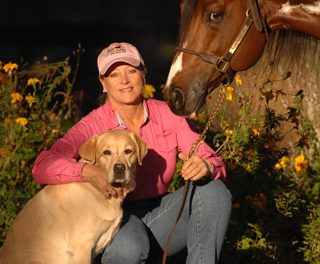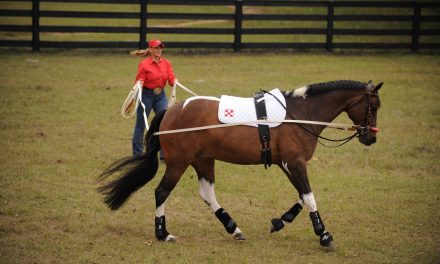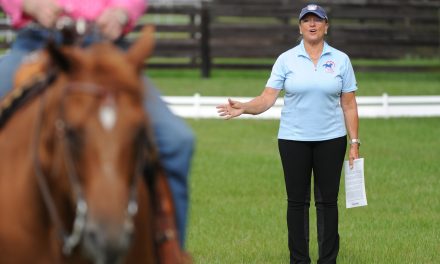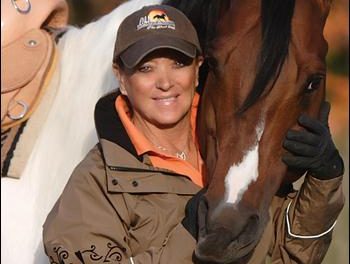Palm Partnership Training™
Building a Partnership with Your Horse
 It is back to the circle pattern we used in the last article about “Falling Out” to learn how to identify, anticipate, and correct the second of two common problems that can occur when turning — when I explained how to properly use the bending and turning aids to correct the problem know as falling out. This week I will explain the problem caused by loss of balance in the horse’s body position called falling in. When a horse is not bending through a turn, he could easily fall in. It may be more of an issue when turning in one direction than the other.
It is back to the circle pattern we used in the last article about “Falling Out” to learn how to identify, anticipate, and correct the second of two common problems that can occur when turning — when I explained how to properly use the bending and turning aids to correct the problem know as falling out. This week I will explain the problem caused by loss of balance in the horse’s body position called falling in. When a horse is not bending through a turn, he could easily fall in. It may be more of an issue when turning in one direction than the other.
Falling in is like a tripping effect, much like if you were to stumble and almost fall. The horse quickens his steps to catch his balance as you would too if you tripped. Falling in may show up as the horse dropping the inside shoulder in a turn, cutting the corner or squaring the corner, or making a turn smaller as a result of not bending while turning. It is the rider’s responsibility to recognize when the horse is falling and know how to correct it using the bending aids and make a wider turn.
The goal for both the bending and turning aids is to control the horse’s body position and his balance. We will use a circle pattern to demonstrate how to correct falling in while bending and turning through a turn.
Start at the walk and bring the horse on a large circle once again to the right. Remember to turn correctly the rider must get the horse bending correctly first. Let’s review those aids. Before the turn bend the horse using the bending aids, the inside leg and open inside rein. At the same, time support the bend with the outside leg applied slightly farther back on the horse’s barrel than the inside leg, and outside indirect rein against the neck to support the flexion of the head and curve of the neck and shoulders. Use the turning aids, the outside leg and outside indirect rein, to direct him through the turn and follow the circle.
If he is straight, the bend in his body from poll to tail (the horse’s spine) will conform to the same arc as that of the circle. The horse being straight while bending means the hind legs track directly into the same track as his front legs. His body alignment stays straight even while bending and turning, His head and neck stay in the middle of the shoulders while curving and his shoulders stay in line with the hips. The hind legs are directly under the hips and the front legs are directly under the shoulders. The hind legs track directly in the same track where the front legs take off. This is called straight while bending.
If a horse, while turning along the arc of a circle, travels too far off the curve and drifts to the inside we say he is falling in. He has lost the proper bend in his body. His head and neck are positioned too far to the outside while his shoulders and hindquarters have left the arc of the circle to the inside. The rider will notice quickness or increase of speed because of the tripping effect. Think about what happens when we lose our balance. Our legs don’t slow, but quicken to regain it. The same thing happens to the horse.
A horse tends to fall in when heading back to the gate or barn.
To correct falling in when on a circle to the right, use the inside leg slightly behind the girth to move the horse out toward to the left to make the circle bigger and bring his barrel (body) and hips back on the circle. Use the inside (right) rein, now an indirect against the neck, to bring his shoulders back to the left and on the circle. Note: the rein cannot be a stronger aid than the leg because it will bend the neck and bring the head flexed inward too much. This will cause more of the horse’s weight to be placed his right front leg, which will swing the hips out—leading to another balance problem!
The inside leg, in this example the right leg, is the most prominent correction aid. Move the horse out with the inside leg and inside rein. Support the horse bending right with the inside leg and indirect inside rein to move the shoulders to the left and also not allowing the neck to bend too much. Move the horse out with inside rein and leg. The rider may also have to use an open left rein to encourage the horse to go wide to the left while not allowing the neck to bend too much. The outside (left) leg reminds the horse to stay forward at the walk, trot, or canter.
The turning aids, the outside rein and outside leg, are not as prominent when the horse is falling in. This is because he is already turning too fast. Use the inside aids more and keep the horse wider on a curve so he does not turn so fast. When the rider can get the horse going wider while curving, the turning aids can be very minimal to get him to turn.
Make sure you perfect the walk, then go to the trot work and last to the canter. If you have troubles with your aids coordination or your hands continue to take charge, go back to the slower gait and continue to perfect this. Here’s a tip for improving both the horse and rider. Always repeat the exercise on horse’s stiffer side at least one more time that direction than his better side. Repeat the direction and double the number of repetitions on the rider’s weaker side, too. By “doubling up” practice in the weaker direction of the horse and rider, both will have greater opportunity to improve.
Your Next Step…
Once you have practiced controlling falling in on the circle at the walk, repeat the exercise at the trot. All the aid sequences are the same. However, at the trot you will need to keep your eyes and vision ahead of the horse. Keep looking ahead at each quarter of the circle, visually remembering where the horse fell in. Before that quarter, use the inside bending leg to move the horse out on the circle to make it bigger while lightly applying the inside indirect rein to move the shoulders out on the circle. Support him with the outside leg and rein to improve his balance and keep him from falling in. Your turning aids will be used again on the portion of the circle where he is not falling in. Remember: in last week’s lesson the turning aids are important to help when the horse is falling out. The bending aids and making a curve bigger using the inside aids are the key to improving falling in.
Until then, follow your dreams…




